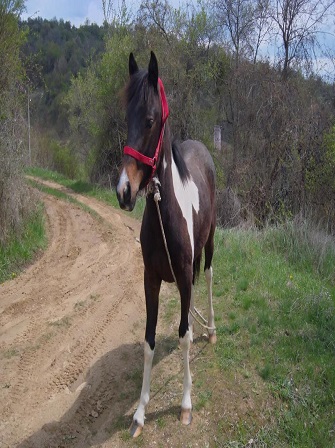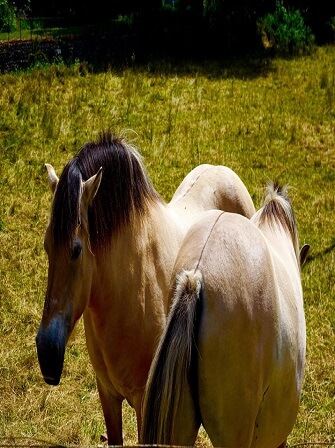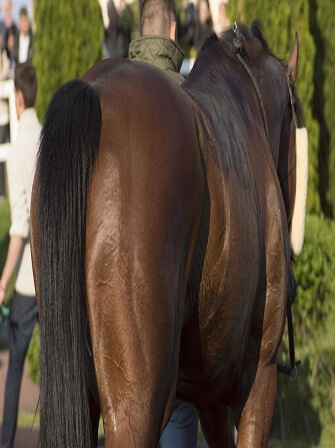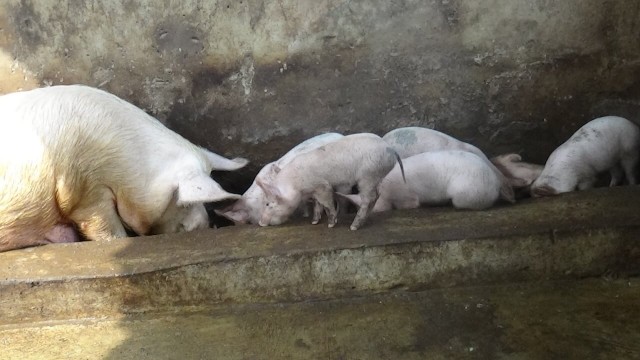
Horse Farm: Production and Management of Horses
September 11, 2022, 2:09 pm
Horse farm management techniques and practices ensures that healthy and strong horses are produced in a horse farm.
Horse Farm: Production and Management of Horses
Horse is a non-ruminant herbivore. A unique physiological characteristics of horse is that it is able to sleep both while standing up and lying down.
The sweat glands of horse are located in the entire body unlike that of cattle that is located in the nose. During a vigorous exercise, horse can be covered by a foam sweat evidence of presence of distribution of sweat glands all over the body.
Most domesticated horses begin training under saddle or in harness between the ages of two and four. They reach full adult development by age five, and are reported to have an average lifespan of between 25 and 30 years.
Horses are used in polo games, racing, ploughing farms, oil mills, warfare, police patrol, crowd control, transportation and festivals e.g. during Durbar
Common Terminologies in Horse Management
To be versed in the horse farm management, you should be familiar with the following terms:
Foal: This is a young horse of either sex less than one year old. A nursing foal is sometimes called a suckling and a foal that has been weaned is called a weanling.
Yearling: This is a horse of either sex that is between one and two years old.
Colt: This is a male horse under the age of four

Filly: This is a female horse under the age of four
Mare: This is a female horse four years old and older

Stallion: This is a non-castrated male horse four years old and older
Gelding: This is a castrated male horse of any age.
Feeding the Horse
Horse is a herbivore with a digestive system adapted to a forage diet of grasses and other plant materials. The major source of nutrient for horse is good quality forage from hay or pasture. Where there is enough land, one acre of pasture land is sufficient for a horse.

Poisonous plants should be checked and removed from the pasture at least on a weekly basis. Young leaves of sorghum contain cyanide and should therefore be avoided in horse feeds. The horse will consume about 2-2.5% of its body weight in dry feed per day.
A 400kg adult horse will consume up to 10kg of dry forage daily. For actively growing horses, concentrate feeds are provided in addition to pasture or hay. However too much of grains e.g. maize should be avoided in the feeds of horses as this may lead to hoof problem e.g. laminitis
Horses should be provided with constant supply of fresh, cool and clean water. The adult horse must be provided with at least 25 liters of water daily. The horse has a relatively small stomach and naturally eats often.
Horses are adapted to eating forages (grasses and hays) due to a microbe-containing hind gut adaptation called the caecum. A horse should be fed at least 1%, preferably 1.5-2% of its body weight in roughage (on a dry matter basis). Feeding too little roughage can lead to severe health conditions such as colic and ulcers.

Grain can be supplemented to the horse’s forage diet if their needs are not being met with forage alone. Some horses will require no additional grain while some may require 1.5% or more of their body weight in grain in addition to forage, to maintain their weight depending on metabolism, age and activity level.
If forage alone is not meeting a horse’s requirements, options include feeding a higher quality forage, adding grain to the forage diet, or replacing part of the horse’s forage with grain.
Feed at approximately the same time each day. This is especially important if you are your horse’s only source of grain and forage (e.g. stabled horses). Many horses will become agitated if they are not fed when they think they should be fed. This often results in digestive disturbances.
Provide free-choice loose salt-vitamin-mineral mix. Horses are not efficient lickers, therefore, salt blocks do not work as well for horses as a loose mixture when compared with sheep, goats or cattle.
Horse Exercise
Horse get bored easily so it is important that they get enough exercise regularly. Exercise also makes the horse physically fit, mentally alert and in possession of good stamina. It is also important that the pasture should be adequately fenced to prevent the horse from escape.

Horse Foot Care
The hooves of a horse are cleaned; any stones, mud and dirt are removed. The feet should be cleaned and dried with towel wherever possible, this prevents lameness. The feet should be cleaned every time the horse is ridden, and even if the horse is not ridden, it is still best practice to check and clean the feet frequently.
Hooves appear to grow faster in warm, moist weather than in cold or dry weather. In damp climates, the hooves tend to spread out more and wear down less than in dry climates. All domesticated horses require regular hoof trims, regardless of use.
Horses subjected to activities such as racing, trekking on hard surfaces need horseshoes for additional protection. The hooves should be trimmed regularly to prevent the problems associated with overgrown hooves.
Manure Disposal in Horse Farm
A mature horse produces approximately large amounts of manure and urine every day. A good way to manage the manure is to collect the manure and compost it for fertilizer application. The open burning of manure as a method of waste disposal causes environmental pollution and therefore should be discouraged. Spreading manure on the pasture should also be discouraged as this practice may be source of worm infestation for the horse

Horse Grooming
An assortment of brushes and other tools are used to groom a horse. Grooming of horse should also be done on a daily basis. Horses can be shampooed and bathed with jets of water from a garden hose. However, regular shampooing can strip the hair coat of natural oils and cause it to dry out.

A well-groomed, clean horse can be kept clean by wearing a horse blanket.
Importance of Horse Grooming
There are certain vital reasons why horses should be groomed and these are:
- Removal of chaff, sweat and other material, which can cause sores on the animal
- Grooming allows the horse handler to check for injuries or unusual bumps or lumps in the skin
- It is a good way to gain the trust of the horse and for the handler to get closer to their horses
- Horses groomed regularly have healthier and more attractive coats, especially when presented for competitions

- Promotion of good blood circulation
Horse Leg Bandage
The horse legs should be wrapped with protective boots or bandages to prevent injury while working or exercising. A too loose bandage will fall off, potentially tangling in the horse’s legs, causing panic or injury. While a too tight bandage may cause injury to tendons, ligaments and possible circulation problems. A bandage is usually applied over a protective padding of roll cotton.
Reproduction in Horses
Horses are bred between 4 and 5 years old. The mare on heat is brought to the stallion’s stall and natural mating takes place. The mare may also be inseminated using fresh, cooled or frozen semen. About 14-16 days after the mare is serviced or inseminated, pregnancy is checked using ultrasound.
A second check is usually performed at 28 days. If the mare is not pregnant, she may be bred again during her next cycle. Unlike in cattle, it is considered safe to breed a mare to a stallion of much larger size. This is because of mare’s type of placenta and its attachment and blood supply, the foal will be limited in its growth within the uterus to the size of the mare’s uterus, but will grow to its genetic potential after it is born. The average gestation length (duration of pregnancy) of mares is about 11 months.
Signs of Approaching Parturition in Horses
- Increase in udder development beginning 2 to 6 weeks before foaling
- Milk is let down into the teats (teat distension) 4 – 6 days prior to parturition
- Covering of teat with colostrum about two days before foaling. This is known as waxing of teats
- Occasional dripping or streaming of colostrum. If this streaming is continuous, the colostrum should be collected and stored for possible use with the newborn foal
- Muscular relaxation in the pelvic region occurs progressively during the last 7 – 14 days of gestation
- Relaxation of mare’s vulva begins during the final days of gestation
A foaling mare should not be placed in a strange environment or have a stranger act as night attendant immediately prior to parturition. Any sudden changes may delay foaling. Ideally, mares should be placed in the foaling environment 2 to 3 weeks prior to her expected foaling date.
For mares foaling in a stall, the stall should be freshly bedded with clean, dry straw rather than wood shavings. About 20 – 25cm thick bed of straw will decrease dust, chances of infection, and is easier to clean.
The mare should be allowed ample exercise up to foaling. Stall confinement for an extended period just prior to foaling may predispose the mare to impaction colic and abnormal swelling.
Mares foaling in paddocks or pasture should either be isolated or have sufficient space to separate themselves from any other horses in the pasture. Additionally, the pasture should be examined for possible hazards to the foal. A shelter should be provided in case of wet or cold weather.
Regardless of the place, the foaling area should be isolated and quiet. Safety of the mare and foal should be kept in mind when deciding where the foaling will occur. Cleanliness of the foaling area is very important. Foaling in contaminated areas can predispose the foal to bacteria invasion and neonatal septicemia via the navel stump. Foals are weaned at 5 and 7 months of age.
Health Management of Horses
Horses need annual vaccinations to protect them against sicknesses. Some of the vaccines are shots of anti-rabies, anti-tetanus, equine encephalitis, equine influenza. As a general rule, a horse that has never had a particular vaccination will be given an initial vaccination and then a booster a few weeks later, then normally once a year after that.

Some steps to reduce parasitic infections include regular removal of feces from the animal’s stall, shed or field; breaking up of feces in fields by harrowing or disking; minimizing of number in fields; periodically leaving a field empty for several weeks; or placing animals other than equines on the field for a period of time, particularly ruminants, which do not host the same species of parasites as equines.
Horses are affected by parasites such as roundworms, pinworms, tapeworms, strongyles and bot flies. Internal and external parasites should be controlled regularly. However, internal parasites cannot be completely eliminated. Therefore, horse owners are advised to give antihelmintic drugs (wormers) to their horses to manage parasite populations.












Share This Article: